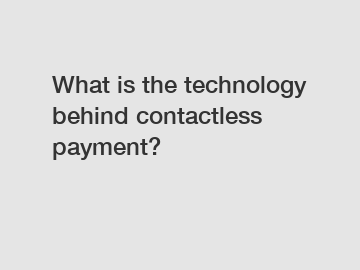What is the technology behind contactless payment?
What is the Technology Behind Contactless Payment?
Contactless payment has revolutionized the way we make transactions, providing a more convenient and efficient method of payment. From tapping our cards or phones at a point-of-sale terminal to making payments through wearable devices, contactless payment has become ubiquitous. But have you ever wondered what technology enables this seamless payment experience? In this article, we will explore the technology behind contactless payment.
Radio Frequency Identification (RFID) Technology.

One of the key technologies behind contactless payment is Radio Frequency Identification (RFID). RFID uses electromagnetic fields to automatically identify and track tags attached to objects. In the case of contactless payment, these tags are embedded in the payment cards, smartphones, or wearable devices. The RFID tags contain an antenna and a small microchip that stores the necessary payment information.
Near Field Communication (NFC).
Near Field Communication (NFC) is a subset of RFID technology and plays a vital role in contactless payment. NFC enables the communication between the payment device and the point-of-sale terminal. It allows secure data exchange between two devices that are in close proximity to each other (within a few centimeters). When you tap your card or phone on the payment terminal, NFC establishes a connection, and the necessary payment information is transmitted securely.
Secure Element.
A crucial component of contactless payment technology is the Secure Element. The Secure Element is a tamper-resistant hardware chip that stores sensitive information, such as payment credentials and cryptographic keys, securely. It ensures that your payment data remains protected against potential threats, such as unauthorized access or data breaches. The Secure Element may be located either on the payment card itself, within the smartphone's hardware, or in wearable devices.
Tokenization.
To enhance the security of contactless payment, tokenization is employed. Tokenization replaces sensitive payment information, such as credit card numbers, with unique identification numbers called tokens. These tokens are useless to hackers even if they manage to intercept them. Tokenization adds an extra layer of security by ensuring that the actual payment details are not exposed during the transaction.
Transaction Process.
Once you tap your card or phone on the payment terminal, several steps occur to complete the transaction securely. First, the payment device and the terminal establish a connection through NFC. Next, the necessary payment information, such as the token or encrypted data, is transmitted from the payment device to the terminal. The terminal then sends this data to the payment processor or the card network for verification. Finally, the payment processor or card network confirms the transaction, and an approval or denial signal is sent back to the terminal.
Advantages of Contactless Payment.
Contactless payment offers numerous advantages over traditional payment methods. It provides a faster and more convenient method of payment, eliminating the need for cash or physical cards. Contactless payment is especially beneficial in high-volume environments, reducing waiting times and increasing customer satisfaction. Furthermore, contactless payment is highly secure, thanks to the tokenization and encryption techniques used to protect the payment information.
In conclusion, contactless payment relies on RFID technology, specifically NFC, to establish a secure connection between the payment device and the point-of-sale terminal. It utilizes a Secure Element to store and protect sensitive payment information, and tokenization enhances the security of the transaction. With its convenience, speed, and security, contactless payment has become widely adopted in various industries. So, why not embrace the future of payments and enjoy the benefits of contactless payment?
If you have any further inquiries or would like to learn more about contactless payment, please feel free to contact us.
Are you interested in learning more about customize software for parcel carrier companies, logistics shipping software, multicarrier parcel management solutions software cost? Contact us today to secure an expert consultation!
96
0
0

Comments
All Comments (0)